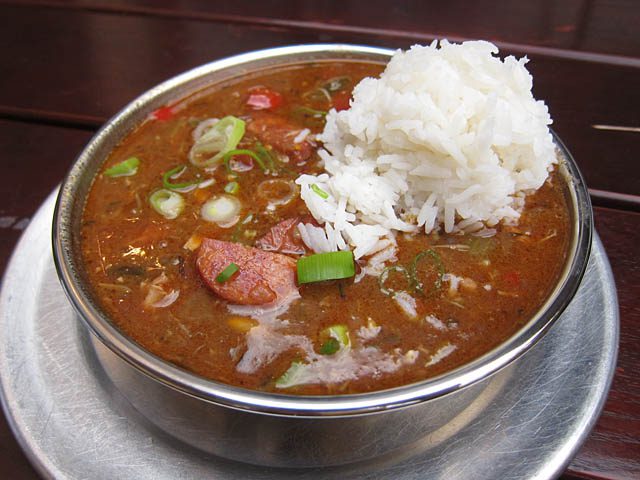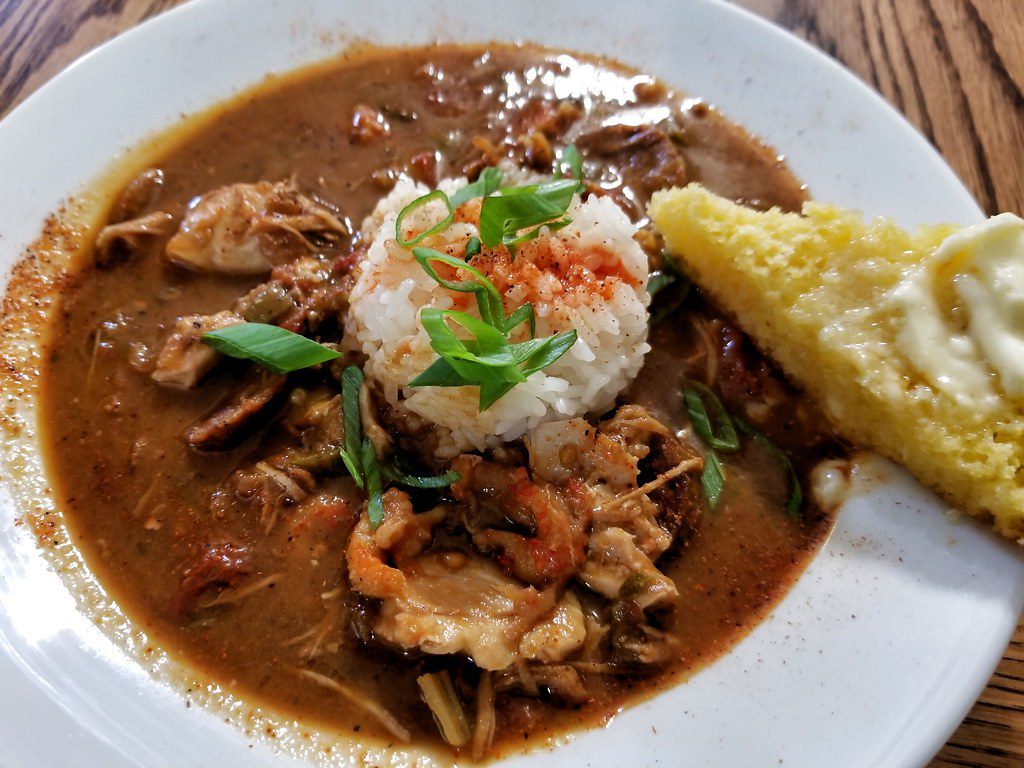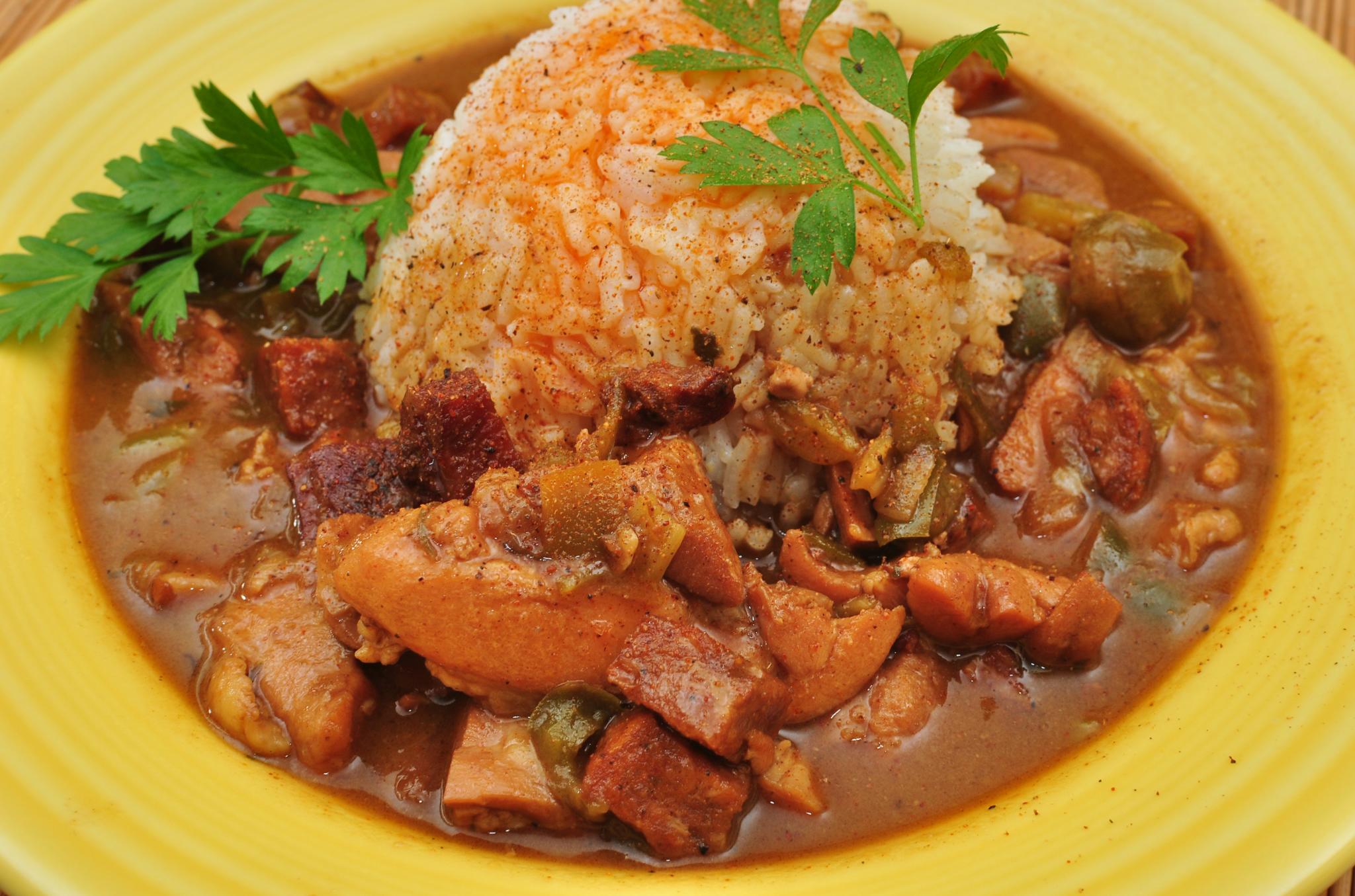Gumbo (Louisiana Creole: Gombo) is a stew popular in the U.S. state of Louisiana, and is the official state cuisine. Gumbo consists primarily of a strongly-flavored stock, meat or shellfish, a thickener, and the Creole “holy trinity” ― celery, bell peppers, and onions. Gumbo is often categorized by the type of thickener used, whether okra or filé powder (dried and ground sassafras leaves).
Gumbo can be made with or without okra or filé powder. The preferred method in the historical New Orleans variation is with a French dark roux. The flavor of the dish has its origins in many cultures. Creole gumbo generally contains shellfish, and a dark roux, filé, or both. Tomatoes are traditionally found in Creole gumbo and frequently appear in New Orleans cuisine but there is a “camp” of gumbo cooks who believe that tomatoes should not be used with okra.

Cajun gumbo is generally based on a dark roux and is made with shellfish or fowl. Sausage or ham is often added to gumbos of either variety. After the base is prepared, vegetables are cooked down, and then meat is added. The dish simmers for a minimum of three hours, with shellfish and some spices added near the end. If desired, filé powder is added after the pot is removed from heat. Gumbo is traditionally served with rice. A third, lesser-known variety, the meatless gumbo z’herbes, is essentially a gumbo of slow-cooked greens.
Where did gumbo come from? The answer can be found in its very name. In several West African languages, the word for okra is ki ngombo, or, in its shortened form, gombo.” Early on, the word was frequently used alongside “okra” by English writers. In the 1840s, when okra was just starting to be grown widely outside the coastal South, newspaper ads commonly offered seeds for “Okra or Gombo.” “Gombo” is still the French word for okra today.
The roots of gumbo do run deep in Louisiana. Enslaved Africans were brought to the French colony in large numbers starting in 1719, and by 1721 more than half the residents of New Orleans were African. The first known reference to gumbo as a dish was uncovered by historian Gwendolyn Midlo Hall, who found a handwritten transcription of the interrogation of a 50-year-old slave named Comba in New Orleans in 1764. Suspected of being associated with other slaves who had stolen clothes and a pig, Comba is asked whether she had given a slave named Louis un gombeau, and she replies that she did.

A more detailed description was published two decades later in a French journal called Observations sur La Physique, which included an article on the American plant sassafras. The author noted that in Louisiana its leaves were dried and ground into a powder. “These leaves are used in sauces,” he wrote. “A pinch of this powder is enough to make a viscous broth.”
The article also noted, “This is the dish we in America call gombo. However, we must distinguish this American stew from the one called gombo févi. This is done with the pods of a species of mallow, known to botanists as the sabdariffa.” Févi, it turns out, is the Louisiana Creole word for okra, and the author notes that its thickening power is even stronger than that of powdered sassafras, which the Creoles called filé.
But which came first, the févi or the filé? Some commentators have argued for filé and claim the word “gumbo” actually comes from kombo, the Choctaw term for powdered sassafras. But I’ve not been able to turn up a single example of a dish being called “kombo” in any 18th or 19th century source, while there are countless examples of a dish made from okra being called either “gombo” or “gumbo.” By the time Peyroux was writing his treatise on sassafras, Africans had been present in Louisiana for some 60 years, plenty long enough for their traditional okra-based stews to have entered the larger culinary culture of the colony.
The most probable path is that Louisianians were eating a thick stew they called “gombo” after its main ingredient, okra. Cooks found they could achieve a similar thickness using the filé powder made by the local Choctaw, and they started substituting that when okra wasn’t available.
According to en.wikipedia; southernfoodways.org; seriouseats.com. Source of photo: internet








